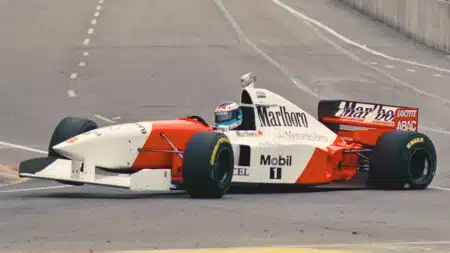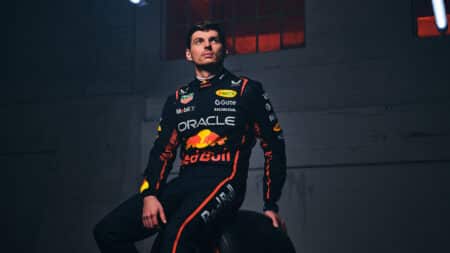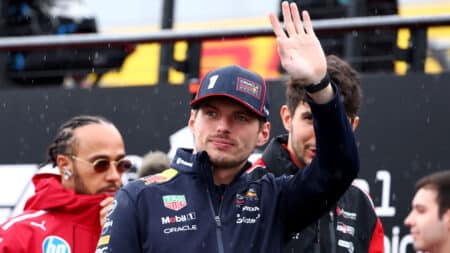Part one of three of an extract from Gordon Kirby’s book Mario Andretti: A Driving Ambition, available here
Click here to buy the above image
As the 1976 season unfolded Lotus engineers Peter Wright and Ralph Bellamy were working on an all-new car for 1977. The car they produced – the Lotus 78 – was the first ‘ground-effect’ F1 car and it introduced a true revolution to the sport. The first type 78 was ready for testing in the fall of 1976 and Gunnar Nilsson ran the car a number of times at Snetterton before the end of the season. Colin Chapman even considered taking the revolutionary new car to that year’s Italian GP but thought better of showing his new baby too early.

If any man deserves to be called the father of ground-effect technology it’s Peter Wright who worked for Lotus in many engineering capacities from 1973-94. “I worked on road cars, racing cars, pleasure boats, racing boats, airplanes and, believe it or not, flying saucers!” Wright explains. “It was never, ever dull.”


Wright, behind Colin Chapman, at Monza, 1981
Wright is now the FIA’s technical advisor with worldwide responsibility for racing and passenger car safety. In the late ‘60s Wright did a design study for a wing-shaped BRM F1 car that was never built and then suggested to Robin Herd that he try aerofoil-shaped sidepods in the March 701 F1 car that Mario Andretti raced in 1970.
“Out of the BRM work came the March,” Wright says, “and out of the March really nothing more happened until we started the program with Ralph on the Type 78. Tony Rudd recruited me to Lotus to run a composite development company within Lotus, and Tony was sent up to Ketteringham Hall by Chapman to rethink the grand prix car. Ralph Bellamy was the designer and I was told to run the wind tunnel with Ralph in my spare time.
“I dug out the old ideas on ground effect and we actually sat down with the type 78 and said, let’s start from first principles and see what we can do with a pencil-thin car. Let’s find out what sort of nose it wants, what sort of sidepods it wants, and where do we put the radiators. We did everything from scratch with a proper wind tunnel program.”
Wright did his wind tunnel work at London’s Imperial College, where a rolling road had been designed and installed by John Stollery, who had been the aerodynamicist for British land and water speed record king Donald Campbell. “That was the first rolling road I’m really aware of,” Wright says. “I wouldn’t like to say it was the first, but it was probably one of the first. The first one certainly used in motor racing.

“We heard that when the type 78 came out Ferrari built an equivalent version and tested it in a tunnel in Italy. I’m not sure which one, possibly Pininfarina, but without a rolling road, and they said, ‘Ah, it doesn’t work.’ So yes, if you don’t have a rolling road you will definitely get the wrong airflow conditions underneath the car.”
Wright explains the process of designing the 78. “We started by looking to see whether we wanted a wide nose or front wings and we played around a little bit with front wings near the ground and looked at the effect of wheels and what the effect was of the height above the ground. We got a quite a long way down the wind tunnel program and we had the radiators in aerofoil section sidepods.
“It didn’t do very much but it was a way of putting some fuel in the car and the radiators in without any sort of penalty. Ralph wanted to move the weight back a bit so the radiators needed to go in the side rather than the nose.”

Wright says the chimera he’d been chasing suddenly took shape one day in the wind tunnel. “One famous day we started getting very inconsistent results and I noticed that the sidepods were sagging. We did some back-to-backs. We wired them up and got them to work properly, so that they didn’t move, and then we got consistent results again. Thinking about it, we said it must have been the gap between the sidepod and the road. So we filled in the gap with pieces of card paper and eureka!


“It all went click, click. About six years work suddenly went click, like it does. If you thrash around in the right area, you’ll find it in the end. And really, from that point onwards it was an intensive program.”
Like Tony Rudd before him, Wright was moved to Team Lotus at Ketteringham Hall to work with Ralph Bellamy and spent a year doing development work on skirts and skirt systems. “We had a Renault 4 van which we used to mount skirts on the back and rush around with me hanging out the back watching them, which was very instructive,” Wright observes. “And we came up with a skirt system about a third of the way through the year that first ran at Zolder and completely transformed the 78, and really made it work.
“It was all about making skirts that didn’t wear out and that worked. Part of it was coming up with a ceramic rubbing strip for the skirts, and then building ones that sucked down instead of sucked up. That was worth seconds a lap. We were trying to work within the rules but the rules really were not very clear. We believed you couldn’t have a sliding skirt, that it had to flex.”
Mario recalls learning the value of sealing the gap between the sidepod and road at an early test of the then-secret type 78. “We were testing at Hockenheim and Colin put brushes on to try to go as close to the ground as possible. We had some photos taken and it showed that going down the straightaway the brushes were blown out. So we were losing all the air. We were losing a lot of flow.”


Chief mechanic Bob Dance was sent to a hardware store to pick up some sheets of plastic. “We put solid plastic on there,” Mario relates. “I’d go out and for a lap or two and I was just flying. I was almost doing the chicane flat, but then the thing would wear out and we would lose speed. That’s when we came up with the idea of skirts.
“They started putting it in the wind tunnel and realised it was more than just a wing working. It was creating a suction. We didn’t know that. Until we actually closed the pods with skirts, they didn’t know this was ground-effect. They thought of it strictly as a wing.”
It took a few years for anyone to realise that much stiffer spring rates were required to maximise a ground-effect car. “We had the car mechanically correct but even then we weren’t taking advantage of the aerodynamics because the car was so soft,” Mario says. “We were still running it so soft. We weren’t taking full advantage of it. We were halfway, but we were paying the penalty on the straightaway. We were really slow in a straight line. The car was a slug.
“I’ll take some credit for really working the suspension. I still had a good feel, once I was really involved, to work the car mechanically. The 78 really worked well mechanically because we were really quick in slow corners where you don’t have much aerodynamic effect at all.”
Adds Peter Wright: “I wasn’t at the races, but I think Mario contributed a lot in sorting the car out. There’s no doubt he was a major part of the whole thing.”
Part two of this feature will be posted tomorrow










